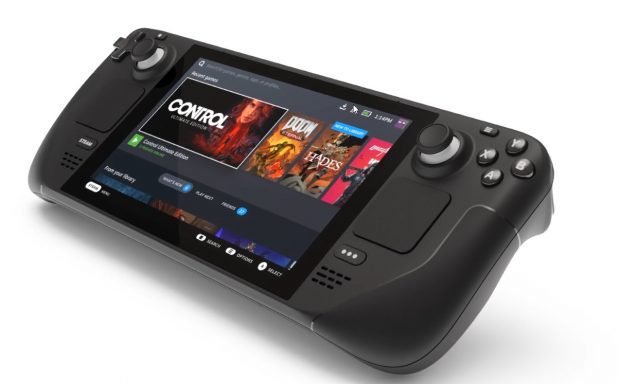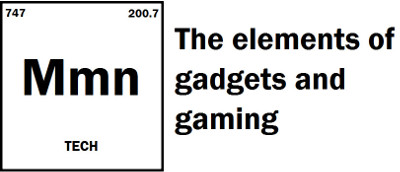

Valve announces Steam Deck handheld, coming this Christmas
Every now and then, the games industry still manages to surprise me in a delightful way. There’s been rumours about a Steam powered handheld for years. In fact, we first mentioned it all the way back in 2014. Well now the Steam Deck is real, and it’s spectacular.
The console clearly takes a lot of its design queues from the Switch, with its large 7” 1280×800 touch display flanked by controllers at the side, which are sadly non-detachable. Under the hood we get a quad-core AMD Zen 2 based processor running at 2.4-3.5GHz. The GPU meanwhile is an RDNA2 based chip with 8 CUs, capable of 1.6 TFLOPS peak. They’ve also managed to stuff in 16GB of LPDDR5 RAM and up to 512GB of NVMe storage, with a MicroSD slot for expansion. These specs put it fairly close to the base PS4 in terms of raw power. Despite that, Valve claims you’ll be able to get 2-8hrs of battery life depending on the game. All of which certainly blows the doors of the Nintendo Switch. Speaking of which, pricing starts at $399 USD, making it only $50 more than Nintendo’s new OLED model. You can read the complete list of specs on Valve’s website.
While it’s been talked for a very long time, the announcement of the Steam Deck seemed to come completely out of the blue. We’d heard no recent rumours about the device. But it’s certainly an interesting take on the handheld form factor. The timing is interesting too, given it was put out just a week after Nintendo unveiled their incredibly underwhelming OLED Switch. Though I think what’s most surprising to me is not that Valve finally did it, but rather what’s under the hood.
There’s been a lot of recent attempts by Chinese startups to make PC based handhelds. Something that has only accelerated in the part couple of years. Now, there’s absolutely nothing wrong with these systems. They work pretty well from what I’ve seen. But they all use off-the-shelf components. Which again isn’t necessarily a drawback. It’s a lot easier and cheaper to work with known variable. However, what Valve has done here is make something completely new from the ground up.
AMD currently doesn’t make any SoCs that pair a Zen 2 based processor with RDNA2 graphics. All current models still used older GCN5 Vega GPUs. Meanwhile, support for DDR5 memory isn’t expected to launch until AMD’s next generation Ryzen. This means that Valve has gone with a fully custom chip for the Steam Deck, and that’s a huge deal. Designing custom hardware like this has a lot of R&D costs involved. So what this tells me us this isn’t just some side project like the Steam Boxes were. Valve is dead serious about getting into the handheld console market, and they’re pulling out all the stops to make that happen.
The aggressive pricing is also another strong indication of this. While the $399 model only contains a scant 64GB of eMMC storage, it still contains the same specs as all other units. The top end 512GB flavour clocks in at $649. Which makes it more expensive than even the PS5 and Xbox Series X. But it’s still a lot cheaper than every other PC based handheld out there. While the GPD Win 3 comes with more storage, it still costs over $1000, while being a decidedly thicker, and less powerful. Like conventional console manufacturers, Valve can do this by subsidizing hardware costs through game sales.
Now, I do see some potential shortcomings for the route they’ve chosen here. First of all, it runs SteamOS, which is now based on Arch-Linux. While Linux gaming has come a tremendously long way in the last few years, largely thanks to Valve and their work on Proton, it’s still not up to par with Windows. A lot of DRM and anti-cheat services that are shoehorned into games don’t always play nicely with the compatibility layers needed for the games to run. It also doesn’t support Windows only services like Game Pass or EA Play. Sure, Valve says you can side load Windows, but that kind of defeats the point of making this a console-like experience. Generally, you want something where every game on the store just works, without having to fiddle with anything.
Also, with the large leaps in the hardware capabilities of current PCs, I do have to question the longevity of this thing. With traditional consoles, you have the advantage of games being optimized for them. Which isn’t always the case. Just look at Cyberpunk 2077, or so many Switch ports. But at least an effort is made. Steam Deck compatibility isn’t really going to factor in a whole lot for PC game development. Not unless the hardware sells extremely well. And $399+ is a lot to spend for a device that’s only going to play indie and older games some 2-3 years down the road.
That said, I find as I get older, graphics have come to mean less to me than they did in the past. The Switch is probably my most played system that I own. While I mostly play it docked, I love having the convenience of a handheld. Yet you can really tell its starting to get long in the tooth. The Steam Deck basically is the Switch Pro we were all asking for. Valve is also an established company that has a track record for making decent hardware. They also have a massive library of games available from the get go. Many of which you probably already own. This isn’t some fly-by-night thing like the Chinese handhelds, or even platforms like Stadia. Though for me, lack of Game Pass support is a bit of a downer. Though there’s nothing stopping Microsoft from porting it to the platform. Or Valve doing their own Game Pass-like service. Steam Deck can also be used as a regular PC in its dock, which adds value. Though unfortunately, the dock is sold separately.
So will I be picking one up? Well, it is expensive. Of course I want to see independent reviews first before plopping down that kind of cash. But this does seem like something that’s right up my ally. And it’s been a long time since we’ve had a truly premium handheld that could take on Nintendo’s monopoly on the form factor. So yeah, I’m excited for this thing when it releases this Christmas. Heck, it might even be my next PC.
